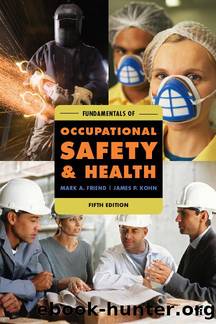Fundamentals of Occupational Safety and Health by Mark A. Friend & Mark A. & Kohn Friend

Author:Mark A. Friend & Mark A. & Kohn Friend [Friend, Mark A. & Kohn, James P.]
Language: eng
Format: epub
Publisher: Government Institutes
Published: 2009-12-31T16:00:00+00:00
Common Problems with Safety Efforts
McSween notes four common problems that seriously hinder safety efforts:
1. Severe Consequences for Reporting Injuries.
There cannot be any pressure to hide injuries and incidents in successful safety efforts. It is important for organizations to learn from their incidents and prevent additional or more serious injuries. Reasons for underreporting include (1) the organization responding to reporting with punishment and (2) peer pressure when incentive programs are based on injury outcomes.
2. Safety Awards Not Related to Behavior.
Safety award programs typically do not reinforce safe behavior on the job. As noted above, awards and incentives tend to influence employees not to report injuries. Many organizations base their awards on outcome measures (injury statistics) rather than process measures—people’s compliance with safety procedures on the job (McSween 1995, p. 15).
3. Dependence on Management or Staff for Planning and Decision Making.
Many companies expect managers to enforce safety rules and procedures. Consequently, employees tend to rely on managers to ensure safe behavior rather than look out for each other. Employees are not adequately challenged to improve safety, and many of them tend to look to someone else for primary responsibility for their safety.
4. Reliance on Punishment to Reduce Risky Behavior.
Many safety programs are based primarily on punishment. Punishment is reactive and focuses on unsafe acts rather than emphasizing safe behavior. McSween notes there are numerous additional problems with punishment that are not readily apparent. For example:
• Punishment is effective only in the presence of the punisher
• Punishment tends to teach the wrong lesson (i.e., don’t get caught)
• Punishment damages relationships and curtails involvement
• Punishment is difficult to maintain (1995, p. 17)
Dominic Cooper adds two important points:
• The effectiveness of punishment depends on its consistency. It only works if given immediately and every time an unsafe behavior occurs.
• Punishment serves more to suppress existing behavior than to encourage new behavior patterns. This . . . can cause anxiety and resentment that surface negatively in other areas of work activity (1998, p. 271).
The point about punishment is not that it is never appropriate, but that it must be balanced. Punishment should be considered a last resort, not a first response.
Unfortunately, overcoming these four common problems does not ensure effective safety efforts. Solving these problems is a step in the right direction and helps establish a solid foundation to build on.
Download
This site does not store any files on its server. We only index and link to content provided by other sites. Please contact the content providers to delete copyright contents if any and email us, we'll remove relevant links or contents immediately.
Whiskies Galore by Ian Buxton(40304)
Introduction to Aircraft Design (Cambridge Aerospace Series) by John P. Fielding(32332)
Small Unmanned Fixed-wing Aircraft Design by Andrew J. Keane Andras Sobester James P. Scanlan & András Sóbester & James P. Scanlan(32137)
Craft Beer for the Homebrewer by Michael Agnew(17440)
Turbulence by E. J. Noyes(7033)
The Complete Stick Figure Physics Tutorials by Allen Sarah(6632)
Kaplan MCAT General Chemistry Review by Kaplan(6045)
The Thirst by Nesbo Jo(5779)
Bad Blood by John Carreyrou(5763)
Learning SQL by Alan Beaulieu(5400)
Weapons of Math Destruction by Cathy O'Neil(5032)
Man-made Catastrophes and Risk Information Concealment by Dmitry Chernov & Didier Sornette(4731)
iGen by Jean M. Twenge(4695)
Digital Minimalism by Cal Newport;(4512)
Life 3.0: Being Human in the Age of Artificial Intelligence by Tegmark Max(4497)
Audition by Ryu Murakami(4093)
1,001 ASVAB Practice Questions For Dummies by Powers Rod(4034)
Electronic Devices & Circuits by Jacob Millman & Christos C. Halkias(4021)
Pale Blue Dot by Carl Sagan(3997)
